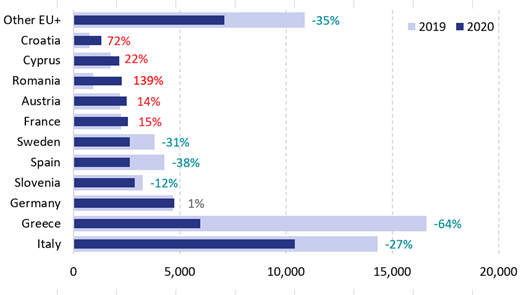

An asylum application can be withdrawn for various reasons before a final decision has been issued. For reporting purposes, withdrawn applications can be measured based on two indicators:
| ‘Explicit’ withdrawals refer to cases where the applicant no longer needs international protection and notifies the authorities to withdraw the application; and | |
| ’Implicit’ withdrawals concern cases where the authorities fail to locate the applicant and therefore it is considered that the applicant has abandoned the procedure. |
Data on implicit withdrawals may cover cases prior to the reference year since an applicant may have absconded long before the withdrawal was noted and reported.
In 2020, about 47,200 applications were withdrawn, the lowest number since 2013 and more than one-quarter less than in 2019. The decline in both the number of applications and the number of withdrawn applications resulted in a ratio of
1 withdrawal for every 10 applications lodged in 2020, similar to 2019. While Eurostat data do not indicate the type of withdrawal, EASO’s provisional Early Warning and Preparedness System (EPS) dataxxxii suggest that most withdrawn applications in 2020 were implicit, as in previous years. Withdrawn applications, especially implicit ones, can serve as a proxy indicator of absconding and the beginning of secondary movements towards other EU+ countries. Consistent with this interpretation, most withdrawals took place in frontline Member States, such as Greece and Italy, which together accounted for more than one-third of all withdrawals.
With regard to the characteristics of applicants, most withdrawn applications continued to be by young males, aged 18 to 34 years.
Although the number declined, Italy recorded the most withdrawals among EU+ countries, with around one in almost every three applications being withdrawn. Greece, which had the highest number of withdrawals in 2019, experienced a sharp drop, and the trend was stable in Germany, with these two countries accounting for around one 1 every 8 and
1 in every 10 withdrawals in EU+ countries, respectively.
 |
Italy and Greece continued to record the most withdrawn asylum applications in 2020 |
Figure 4.14: Changes in the number of withdrawn asylum applications in EU+ countries, 2019-2020
Source: Eurostat [migr_asywitha] as of 28 April 2021.
There were fewer applications withdrawn in the majority of EU+ countries, similar to the trend for the number of asylum applications received. Nevertheless, this was not the case in every country. In some countries, more withdrawals than in previous years were recorded: Austria (with increasingly more Syrians withdrawing their applications), Croatia (with more Afghans, Iraqis and Syrians), Cyprus (with more Georgians), France, Malta (predominantly Sudanese), Portugal (with sub-Saharan Africans including nationals of The Gambia, Guinea, Guinea-Bissau, Morocco and Senegal) and Romania (with more Syrians, Afghans, Turks and Egyptians). The increases occurred especially during the second half of 2020.

[xxxii] In the framework of the EASO’s EPS data exchange, the indicator on withdrawn applications is disaggregated by type of withdrawal (explicit or implicit). Direct comparison of EASO and Eurostat data is not possible. The EASO indicator refers to applications withdrawn during the first instance determination process related to first instance decision-making, while Eurostat data cover applications withdrawn at all instances of the administrative and/or judicial procedure. In addition, the reporting dates differ: EASO uses the date of the decision on the withdrawn application, while Eurostat uses the date the application is considered withdrawn. Finally, the EPS data collection does not cover Iceland or Liechtenstein.



